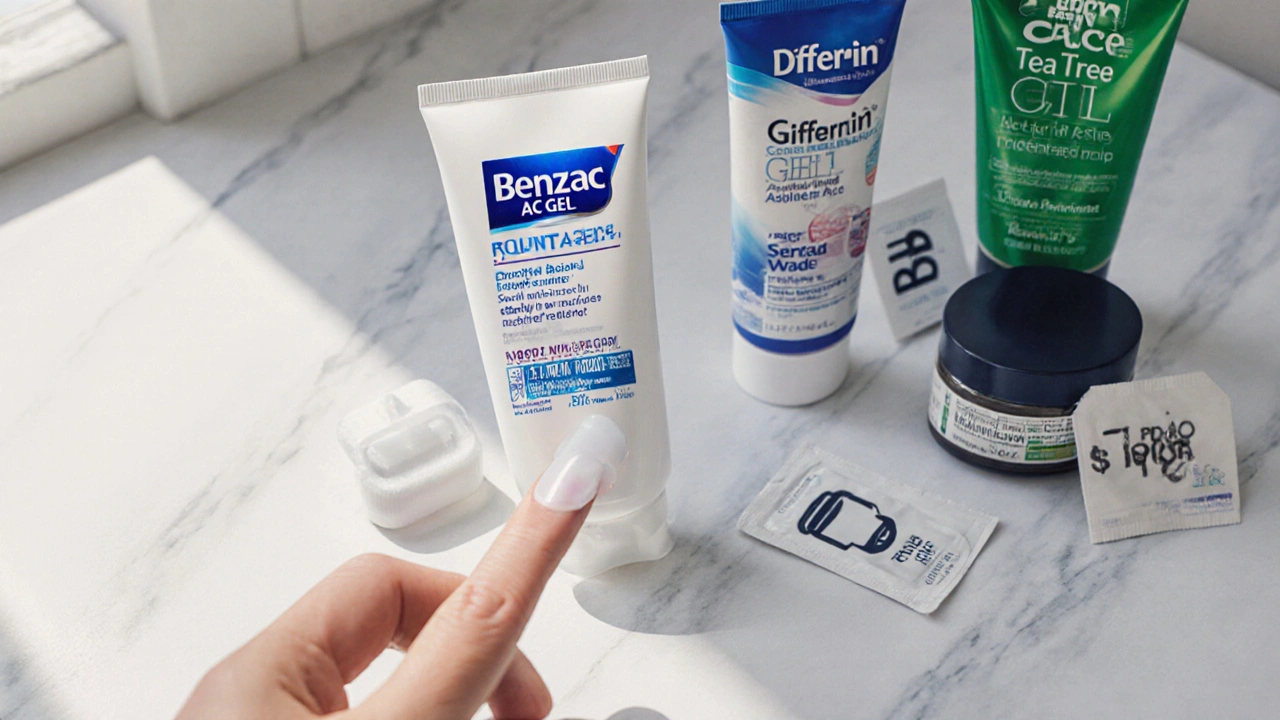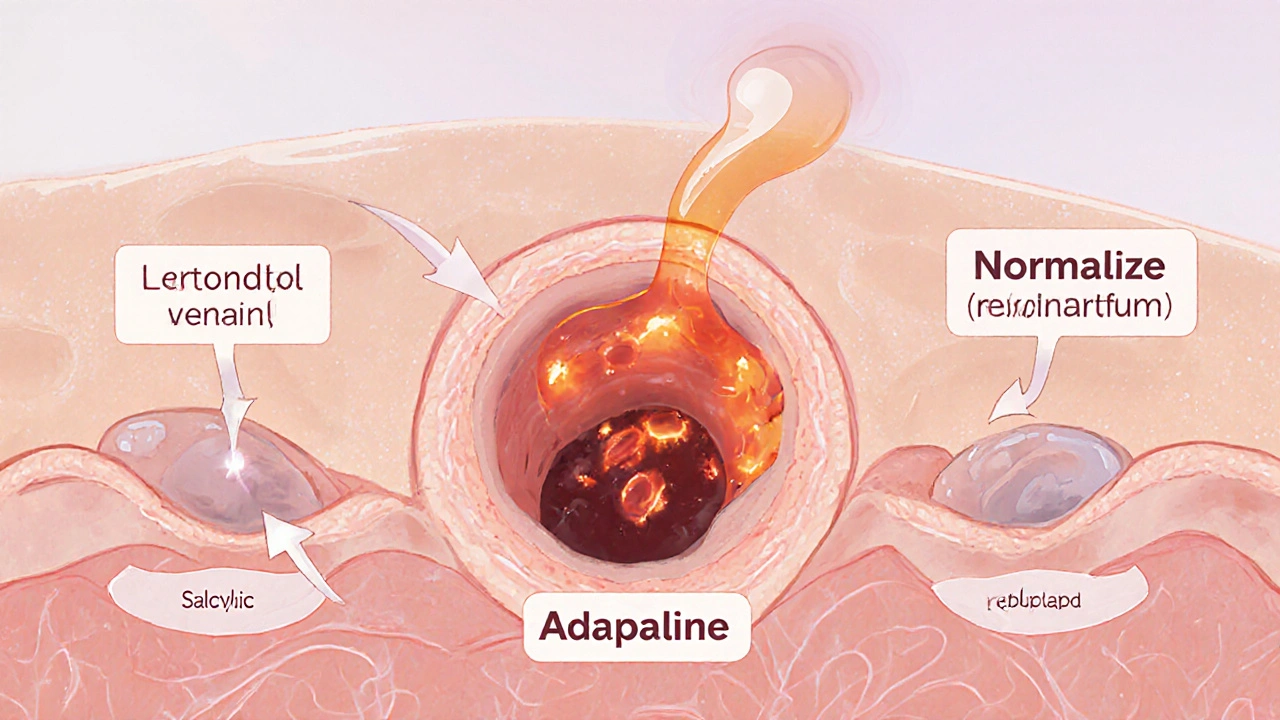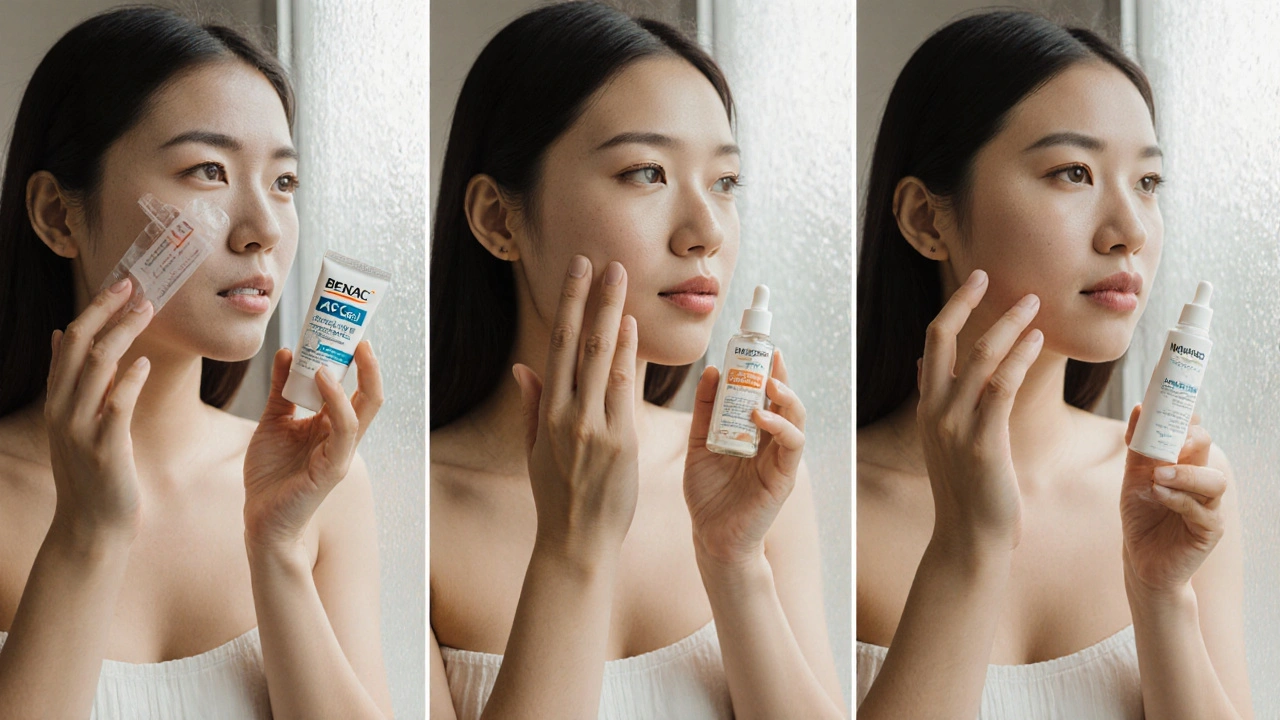
Acne Treatment Selector
Recommended Treatment
Why This Works For You
Key Benefits
Quick Takeaways
- Benzac AC Gel uses 2.5% benzoyl peroxide, ideal for mild‑to‑moderate pimples.
- Alternatives like Differin Gel (adapalene) or salicylic‑acid pads target clogged pores rather than bacteria.
- Price varies widely: generic benzoyl peroxide gels cost $5‑$10, while prescription retinoids can exceed $30 per month.
- Choose based on skin type: oily, acne‑prone skin often benefits from benzoyl peroxide; sensitive skin may prefer azelaic acid or nicotinamide.
- Always start with a patch test and use sunscreen - all acne gels increase sun sensitivity.
What is Benzac AC Gel?
Benzac AC Gel is a topical acne medication that contains 2.5% benzoyl peroxide, a powerful oxidizing agent that kills the bacteria Cutibacterium acnes and helps unclog pores.
The gel format means it dries quickly, leaving a matte finish that most users find comfortable under makeup. It is available over the counter in many countries and is marketed for mild to moderate inflammatory acne.
How Benzac AC Gel Works
Benzoyl peroxide releases free radical oxygen that destroys the cell walls of acne‑causing bacteria. At the same time, it gently exfoliates the surface, shedding dead skin cells that could block follicles. This dual action reduces redness, prevents new breakouts, and speeds up healing of existing lesions.
Because it’s an oxidizer, the gel can cause temporary dryness, peeling, or a mild tingling sensation. Those side effects usually subside after a week of consistent use.

Key Decision Criteria When Choosing an Acne Gel
- Active ingredient - Determines how the product attacks acne (bacterial kill vs. keratolysis vs. anti‑inflammatory).
- Concentration - Higher percentages can be more effective but raise irritation risk.
- Skin type compatibility - Oily skin tolerates stronger agents; sensitive skin needs soothing additives.
- Price and availability - OTC options are cheaper; prescription retinoids may need a dermatologist visit.
- Additional benefits - Some gels include niacinamide, anti‑redness agents, or moisturizers.
Side‑by‑Side Comparison of Popular Alternatives
| Product | Active Ingredient | Typical Strength | Avg. Monthly Price (USD) | Best For | Main Drawbacks |
|---|---|---|---|---|---|
| Benzac AC Gel | Benzoyl Peroxide | 2.5% | 5‑10 | Oily, acne‑prone skin; quick bacterial control | Dryness, possible bleaching of fabrics |
| Differin Gel | Adapalene | 0.1% | 15‑20 | Comedonal acne, post‑inflammatory hyperpigmentation | Initial irritation, requires prescription in some regions |
| Salicylic Acid Pads | Salicylic Acid | 2% (pad) | 8‑12 | Blackheads & whiteheads, sensitive skin | Can be drying if over‑used |
| Azelaic Acid Cream | Azelaic Acid | 15% | 20‑25 | Rosacea‑prone acne, redness reduction | Gradual onset of results |
| Tea Tree Oil Gel | Melaleuca alternifolia Oil | 5% | 10‑15 | Natural‑leaning users, mild breakouts | Potential allergic reactions |
| Sulfur Mask | Sulfur | 10% | 12‑18 | Oily skin, excess sebum control | Distinct odor, can be messy |
| Nicotinamide Serum | Niacinamide | 4% | 18‑22 | Inflammation reduction, barrier repair | Less direct acne‑clearing power |
| Clindamycin Phosphate Gel | Clindamycin | 1% | 30‑40 (prescription) | Inflammatory papules, combination therapy | Antibiotic resistance risk |
Deep Dive Into Each Alternative
Differin Gel (adapalene) is a third‑generation retinoid that normalizes skin cell turnover. Users report smoother texture after 4‑6 weeks, but the first two weeks can feel itchy or burning. It's ideal for those who struggle with clogged pores rather than bacterial overgrowth.
Salicylic Acid Pads exfoliate inside the pore with a beta‑hydroxy acid that dissolves sebum. Because they’re pre‑moistened, they’re convenient for travel, but over‑use can strip the skin’s natural lipids.
Azelaic Acid Cream offers antibacterial and anti‑keratinizing effects while also fading post‑acne marks. Its 15% formula is prescription‑only in the U.S., making it pricier but worthwhile for patients with sensitive, rosacea‑type skin.
Tea Tree Oil Gel harnesses natural terpene compounds that disrupt bacterial membranes. Clinical trials show a 30% reduction in pustules compared to placebo, yet the oil can be sensitizing for some users.
Sulfur Mask absorbs excess oil and reduces inflammation via sulfide ions. It’s a classic acne remedy that still appears in modern formulations, best applied 10‑15 minutes once a week.
Nicotinamide Serum (niacinamide) strengthens the skin barrier and suppresses inflammatory cytokines. While it doesn’t directly unblock pores, it pairs well with benzoyl peroxide or retinoids to minimize irritation.
Clindamycin Phosphate Gel is a topical antibiotic that targets Cutibacterium acnes. It’s often prescribed alongside benzoyl peroxide to prevent bacterial resistance, but long‑term use should be monitored by a dermatologist.

Choosing the Right Product for Your Skin
If you have oilier, acne‑prone skin and need rapid bacterial control, Benzac AC Gel remains a solid first‑line choice. For persistent blackheads or a need to improve skin texture, swapping to Differin Gel may yield smoother results.
When sensitivity is a concern, look to Azelaic Acid Cream or Nicotinamide Serum. Both calm redness without the harsh drying effect of benzoyl peroxide.
Budget‑conscious users can opt for generic Benzoyl Peroxide gels at 2.5% concentration, which cost under $10 a month and perform similarly to brand‑name Benzac.
Finally, if you prefer a natural route, a Tea Tree Oil Gel or Sulfur Mask can supplement your routine, but they rarely replace the potency of prescription‑strength options.
Practical Usage Tips & Safety
- Start with a small area (e.g., behind the ear) for 48‑hour patch test.
- Apply a thin layer once daily, preferably in the evening to minimize sunlight‑induced irritation.
- Follow with a non‑comedogenic moisturizer to combat dryness.
- Use broad‑spectrum SPF 30+ each morning; benzoyl peroxide and retinoids increase UV sensitivity.
- Avoid wearing tight, synthetic fabrics that can trap heat and worsen inflammation.
- If excessive peeling occurs, cut back to every other day and increase moisturization.
Common Pitfalls and How to Avoid Them
Many users stop treatment too early. Expect at least 4‑6 weeks of consistent use before judging effectiveness. Switching products every few days can also cause “reset” of the skin’s adaptation, prolonging acne flare‑ups.
Another mistake is mixing multiple harsh actives (e.g., benzoyl peroxide + high‑strength salicylic acid) in the same routine. Layer them on alternate nights or separate by a few hours to reduce irritation risk.
Frequently Asked Questions
Can I use Benzac AC Gel together with a retinoid?
Yes, but introduce them slowly. Start with the benzoyl peroxide every other night and the retinoid on the remaining evenings. Keep moisturizer in between to buffer potential irritation.
How long does it take to see results with Benzac AC Gel?
Most users notice a reduction in active pimples within 3‑5 days, but visible improvement in overall skin clarity usually appears after 2‑3 weeks of daily use.
Will Benzac AC Gel bleach my clothes?
Benzoyl peroxide can bleach fabrics, especially whites and synthetics. Let the gel fully absorb (about 15‑20 minutes) before dressing, and wash affected clothes separately if you suspect contact.
Is Benzac AC Gel safe for teenage skin?
Absolutely. The 2.5% concentration is designed for over‑the‑counter use, making it suitable for adolescents with mild to moderate acne. Parents should still supervise the first few applications.
What’s the best alternative if I have very sensitive skin?
Consider a low‑strength azelaic acid cream (15%) or a nicotinamide serum. Both calm inflammation without the strong oxidizing effect of benzoyl peroxide.
By weighing active ingredients, skin type, cost, and potential side effects, you can pinpoint the acne gel that aligns with your goals. Whether you stick with Benzac AC Gel or switch to a gentler alternative, consistency and proper sun protection are the final pieces that turn a good product into great skin.
Comments (16)
-
Lily Saeli October 9, 2025
We must ask ourselves why we chase every new acne gel like a cult ritual. The market feeds on our insecurities, turning skin care into a moral test. Choosing a product should be about honest health, not about buying status symbols.
-
Ellen Laird October 10, 2025
The mere notion of settling for a generic benzoyl peroxide is simply unthinkable for someone with discerning skin taste. Only the creme de la creme of dermatological science will ever suffice, definetly.
-
rafaat pronoy October 10, 2025
Honestly, I just slathered the gel on before bed and woke up with fewer red bumps :) It's pretty chill to see the pores clear without a whole pharmacy routine.
-
sachin shinde October 10, 2025
While many users rave about the immediate drying effect, it is essential to recognize the underlying keratinocyte turnover that such oxidizers induce. A disciplined regimen mitigates the potential for barrier disruption, which, if ignored, can exacerbate inflammatory lesions. Moreover, the synergistic pairing with a low‑strength retinoid often yields superior outcomes without the dreaded rebound effect.
-
Leon Wood October 10, 2025
Yo, give Benzac a shot and watch those pimples disappear like magic! Consistency is the secret weapon, and trust me, your skin will thank you. Let’s crush those breakouts together!
-
George Embaid October 11, 2025
Friends, regardless of whether you have oily skin or a more sensitive complexion, there’s a version of benzoyl peroxide that can fit your routine. Pair it with a barrier‑repair moisturizer and you’ll respect both your skin’s needs and cultural beauty traditions. Inclusivity in skincare means we all get a clear canvas.
-
Meg Mackenzie October 11, 2025
I can’t help but feel that big pharma hides the truth about how these chemicals alter our skin’s microbiome. The bleaching of fabrics is just a symptom of a larger agenda to keep us dependent. Stay vigilant, protect your skin, and question the narratives they feed us.
-
Dalton Hackett October 11, 2025
When evaluating Benzac AC Gel against its peers, the first factor to consider is the concentration of benzoyl peroxide, which at 2.5% offers a balanced approach between efficacy and tolerability. The gel’s quick‑drying texture minimizes the greasy feel that often deters users from daily application, thereby improving adherence. Its oxidative mechanism precisely targets Cutibacterium acnes, reducing bacterial load without the need for systemic antibiotics. However, the oxidative stress also leads to transient dryness, a side effect that can be mitigated with a non‑comedogenic moisturizer applied after the gel has fully absorbed. Compared to Differin’s adapalene, Benzac works faster on active lesions but does not address comedonal acne as effectively. Salicylic acid pads, on the other hand, excel at exfoliating within the pore but lack the bactericidal power of peroxide. Azelaic acid provides anti‑inflammatory benefits and is gentler on sensitive skin, yet its higher cost and prescription requirement can be prohibitive. Tea tree oil offers a natural alternative, though studies show variable results and a higher risk of allergic reactions. Sulfur masks are excellent for oil control but are messy and have a distinct odor that many find off‑putting. Nicotinamide serums reinforce barrier function and calm redness, making them ideal adjuncts rather than primary treatments. For patients with severe inflammatory papules, a combination of benzoyl peroxide and clindamycin can be prescribed, capitalizing on both antibacterial pathways. The price variance across these options is notable; generic benzoyl peroxide gels can be sourced for under ten dollars per month, while prescription retinoids often exceed thirty dollars. Accessibility also differs, with OTC products available worldwide, whereas some alternatives require dermatologist visits. Ultimately, the decision should be guided by skin type, tolerance, and budget, ensuring a sustainable routine that users can maintain long term. By understanding each active ingredient’s role, consumers can make informed choices rather than following marketing hype.
-
Boston Farm to School October 11, 2025
I try the gel once a day it feels light and non sticky
-
Emily Collier October 11, 2025
Applying Benzac AC Gel correctly begins with a thorough yet gentle cleanse to remove excess oil and debris from the skin surface. After patting the face dry, dispense a pea‑sized amount onto each affected area, avoiding the delicate eye and lip zones. The gel should be spread in a thin, even layer, allowing it to fully absorb before applying any moisturizer. Waiting roughly fifteen minutes ensures the active ingredient penetrates the follicles without being diluted. A lightweight, non‑comedogenic moisturizer can then be layered to counteract the drying effect, preferably one containing ceramides or hyaluronic acid. Consistency is paramount; even if the skin appears clear after a week, continue the regimen for at least four weeks to prevent rebound flare‑ups. Sun protection is non‑negotiable: broad‑spectrum SPF 30 or higher must be applied each morning, as benzoyl peroxide increases photosensitivity. If irritation arises, reduce application frequency to every other night, gradually building tolerance over subsequent weeks. For individuals with extremely sensitive skin, consider starting with a lower concentration or a mixed formulation that blends benzoyl peroxide with soothing agents. Monitoring progress with a simple photo journal can help track improvements and identify any adverse reactions early. Dietary factors, such as high glycemic load foods, may exacerbate acne, so pairing topical treatment with a balanced diet can enhance results. Hydration supports skin barrier function, further minimizing dryness caused by the gel. Should the breakout persist beyond six weeks, consulting a dermatologist is advisable to explore adjunctive therapies like topical retinoids or oral antibiotics. Remember, the goal is not just to clear existing lesions but to maintain a healthy, resilient complexion over the long term. By adhering to these steps, Benzac AC Gel can be a powerful ally in the fight against acne.
-
Catherine Zeigler October 12, 2025
When you’re looking for a clear path forward, think of your acne routine as a step‑by‑step plan rather than a quick fix. Start with a gentle cleanser, follow with the benzoyl peroxide gel, then seal in moisture. Keep an eye on how your skin reacts, and adjust frequency if you notice excessive peeling. Celebrate small wins, like fewer red spots, because they signal progress. This balanced approach helps you stay motivated without feeling overwhelmed.
-
henry leathem October 12, 2025
The epidermal turnover induced by peroxide doesn’t just “clear pores” – it re‑engineers the desquamation cascade, which many novices overlook. Without a proper barrier strategy, you’ll trigger compensatory hyperkeratosis, nullifying any anti‑bacterial gains. In short, misuse equals counterproductive outcomes.
-
jeff lamore October 12, 2025
Dear community, I appreciate the diverse experiences shared here and would like to add that a consistent nighttime routine often yields the best results. That said, feel free to experiment with daytime application if your schedule demands it, just remember to pair it with sunscreen. Balance and respect for your skin’s limits are key.
-
Kris cree9 October 12, 2025
Stop overcomplicating acne care.
-
Paula Hines October 13, 2025
In the grand narrative of skin health the western pharmaceutical monopoly seeks to impose its standardized formulas upon a world that values natural resilience and cultural diversity yet Benzac AC Gel, with its aggressive oxidizing action, epitomizes the very homogenization that undermines indigenous approaches to complexion care the truth lies in understanding that the skin’s microbiome is not a battlefield for synthetic chemicals but a symbiotic ecosystem that thrives when we respect its equilibrium thus when we blindly adopt a one‑size‑fits‑all gel we not only surrender our individuality but also feed into a profit‑driven agenda that prioritizes revenue over genuine wellbeing and this realization should compel us to seek alternatives that honor both scientific rigor and cultural heritage while demanding transparency from manufacturers who would otherwise conceal the long‑term effects behind glossy packaging. Only by reclaiming agency over our own skin can we break free from the imposed paradigm and cultivate a future where acne treatment is a choice rooted in knowledge not coercion
-
John Babko October 13, 2025
Indeed, the market offers a plethora of options, from benzoyl peroxide gels, to retinoid creams, to natural oils, each with its own set of benefits and drawbacks, and while some users prefer the quick action of peroxide, others cherish the gentler approach of azelaic acid, making the decision highly personal, and ultimately, the best regimen is one that aligns with your skin type, lifestyle, and budget, so take the time to assess, test, and adjust accordingly.
